Abstract
A 29-yr-old woman with systemic lupus erythematosus (SLE) was found to have no detectable C3b/C4b receptors (CR1) on her erythrocytes (E) when they were assayed by the binding of rabbit polyclonal and murine monoclonal (Yz-1) anti-CR1. Analysis by two-color fluorescent flow cytometry of CR1 expression on the patient's B lymphocytes that had been stained indirectly with monoclonal anti-B1 and rabbit F(ab')2 anti-CR1 also revealed a marked deficiency of CR1. Total cellular CR1 of neutrophils, assessed by a sandwich radioimmunoassay, was about half that of neutrophils from normal individuals. Because her E had expressed 173 sites/cell 2 yr before, the CR1 deficiency was considered to be acquired and a possible mechanism was sought. Autoantibody to CR1 was measured by a radioimmunoassay in which serum or its fractions were incubated in microtiter wells that had been coated with purified CR1, and binding of immunoglobulin to the wells was quantitated with 125I-labeled goat IgG antihuman F(ab')2. The CR1-specific binding of immunoglobulin from the patient's serum was 19.1 ng/well of the detecting antibody when her E had eight CR1 sites per cell; that of 28 healthy donors was 1.3 +/- 0.5 ng/well (mean +/- SEM), and that of 34 additional patients with SLE was 0.5 +/- 0.3 ng/well. The activity was present also in purified IgG and its F(ab')2 fragment, indicating that the binding of serum immunoglobulin to CR1 was not mediated by C3 fragments. The specificity of the patient's IgG for CR1 was confirmed when pretreatment of the CR1-coated wells with affinity-purified rabbit F(ab')2 anti-CR1 was shown to inhibit by 68% the binding of the IgG. The autoantibody also interacted with CR1 in cell membranes, as assessed by its capacity to inhibit the binding of indirectly fluoresceinated Yz-1 to neutrophils, and, when combined with goat IgG antihuman F(ab')2, to diminish the binding of dimeric C3b to normal E. During the period of the marked deficiency of CR1 the patient experienced an exacerbation of disease activity which was treated with prednisone. Clinical improvement was accompanied by a decrease in the serum concentration of anti-CR1 to levels present 2 yr earlier, and an increase of CR1 to 170 sites/E. The temporal association between high titers of an autoantibody to CR1, absence of CR1 from E, and heightened activity of SLE suggest that the former may have had a role in the other manifestations of the patient's disease.
Full text
PDF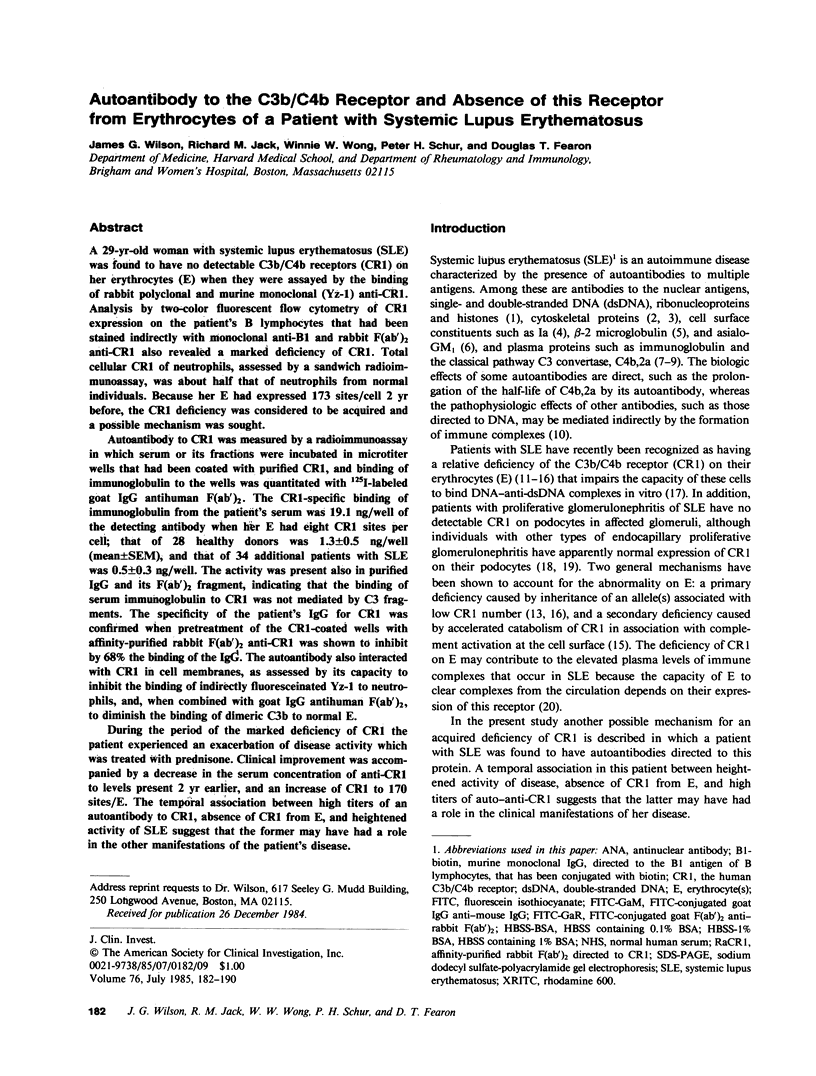

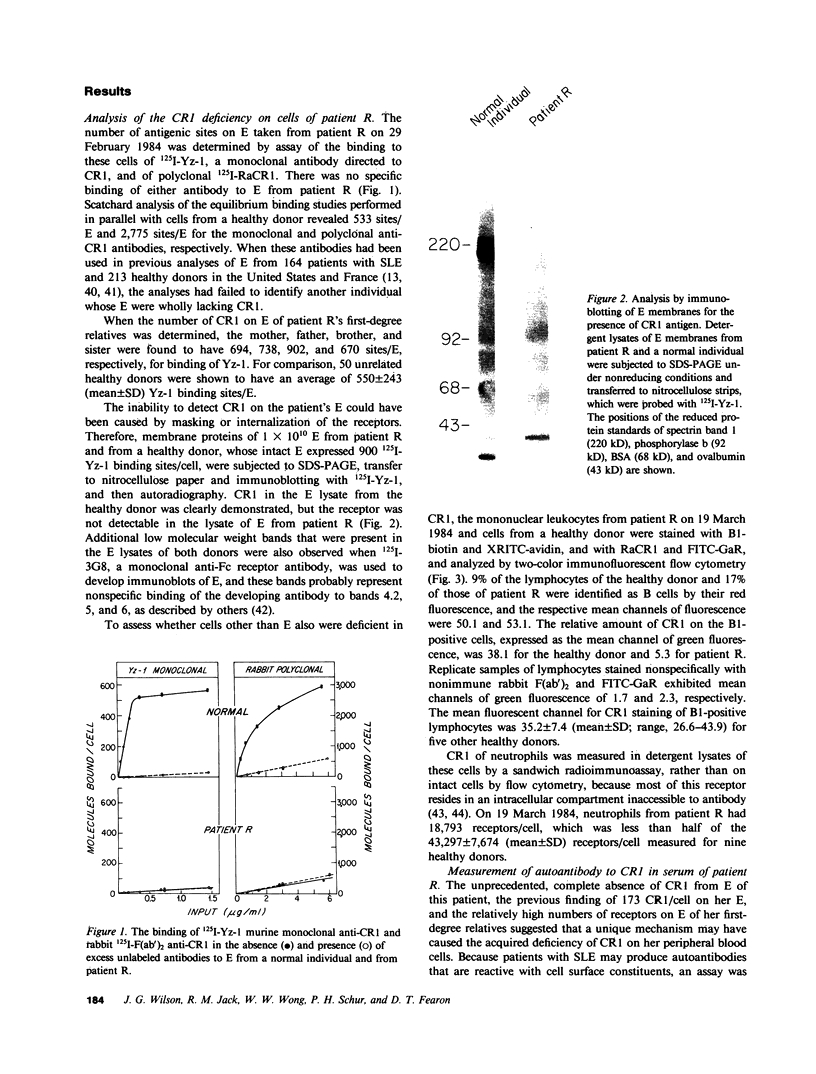
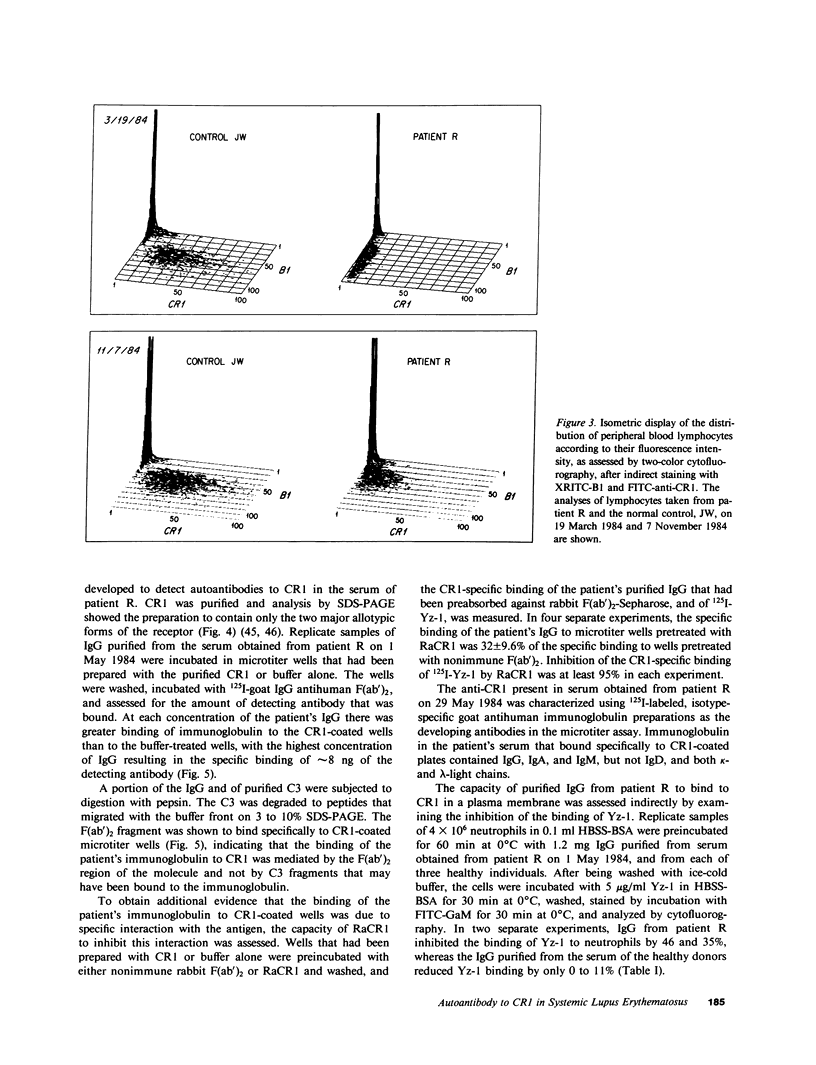
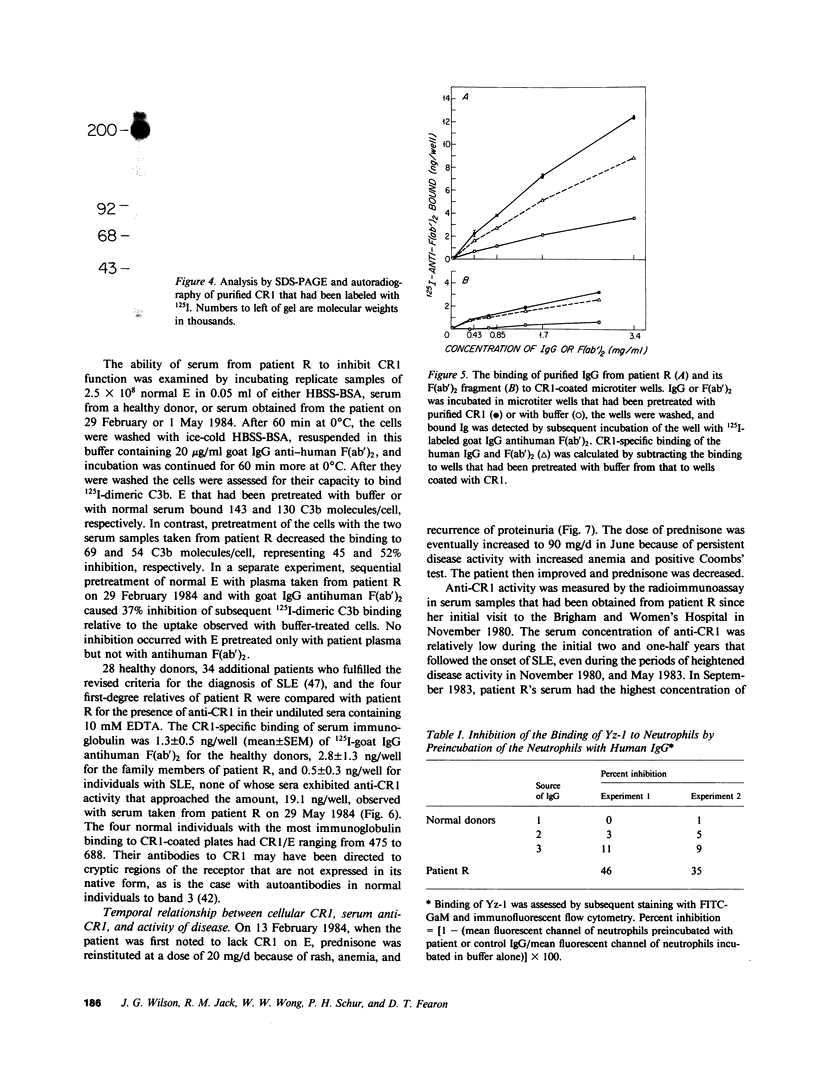
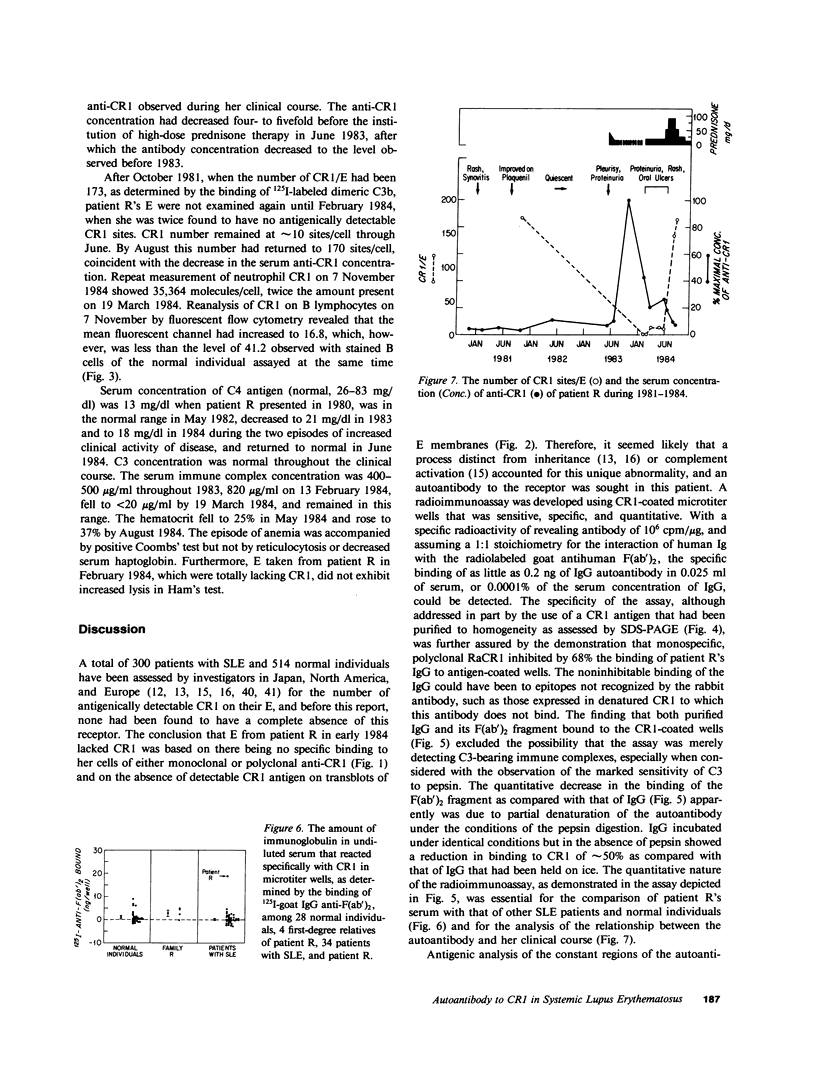

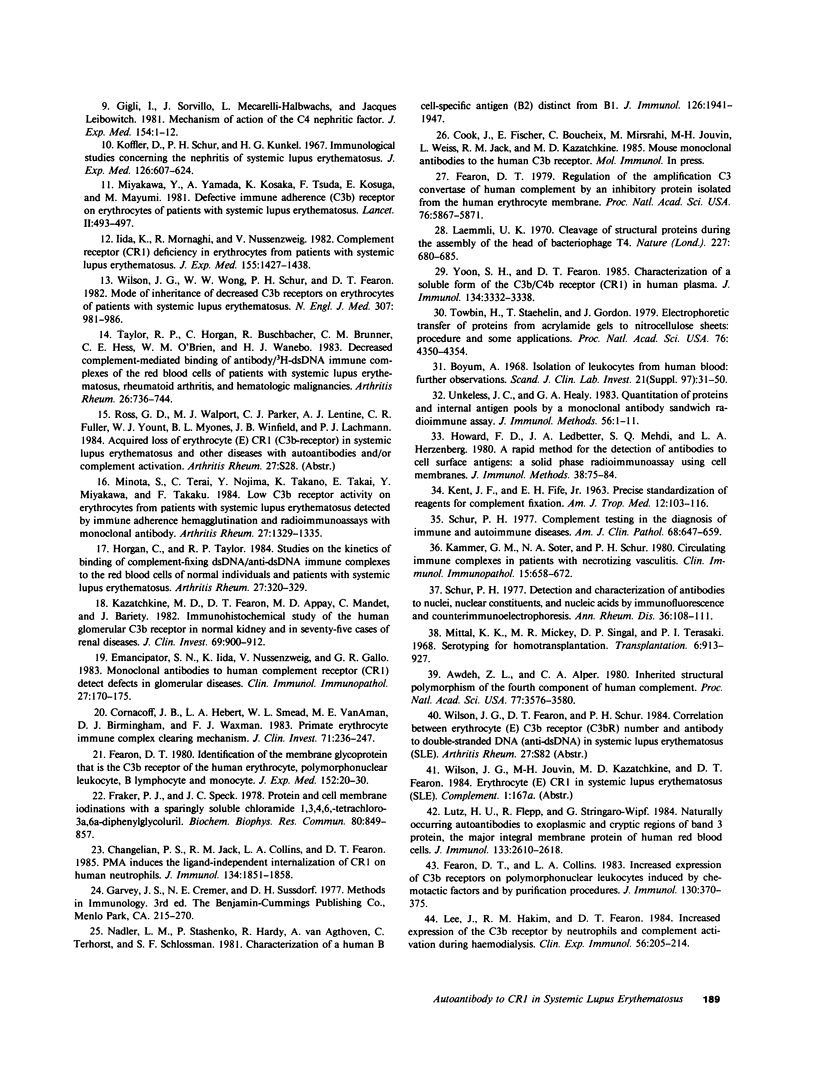
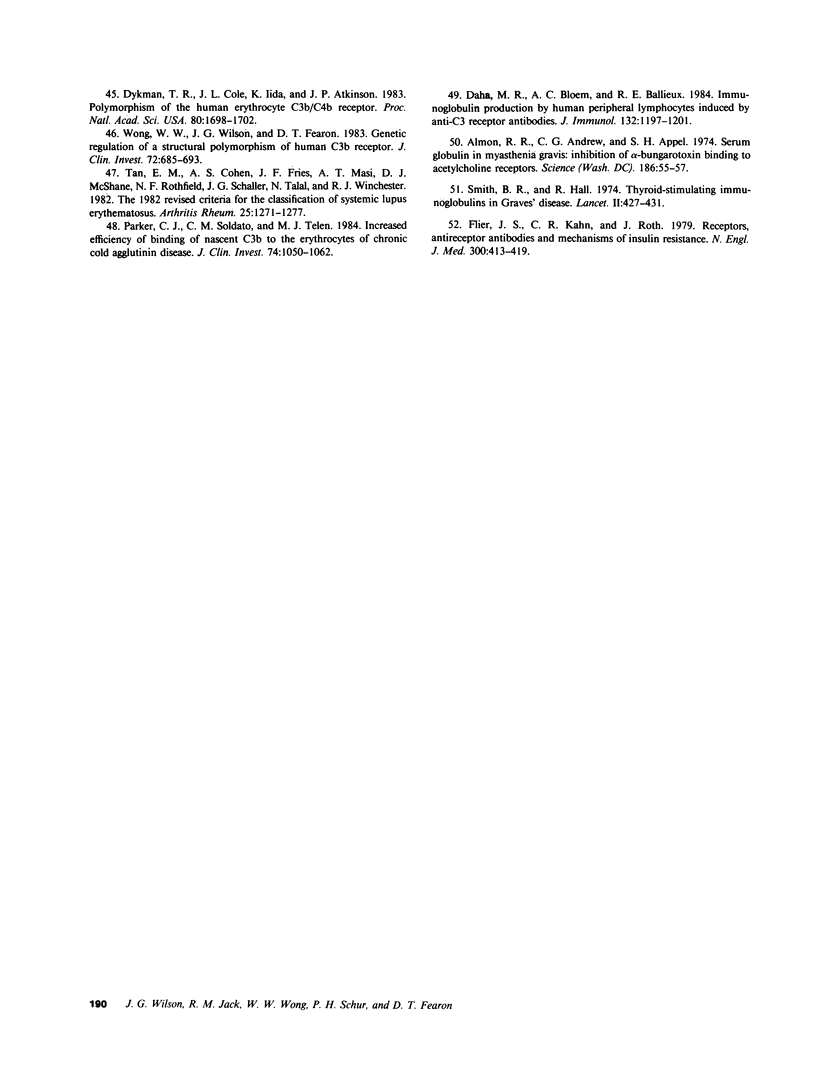
Images in this article
Selected References
These references are in PubMed. This may not be the complete list of references from this article.
- Alcover A., Molano J., Renart J., Gil-Aguado A., Nieto A., Avila J. Antibodies to vimentin intermediate filaments in sera from patients with systemic lupus erythematosus. Arthritis Rheum. 1984 Aug;27(8):922–928. doi: 10.1002/art.1780270812. [DOI] [PubMed] [Google Scholar]
- Almon R. R., Andrew C. G., Appel S. H. Serum globulin in myasthenia gravis: inhibition of alpha-bungarotoxin binding to acetylcholine receptors. Science. 1974 Oct 4;186(4158):55–57. doi: 10.1126/science.186.4158.55. [DOI] [PubMed] [Google Scholar]
- Awdeh Z. L., Alper C. A. Inherited structural polymorphism of the fourth component of human complement. Proc Natl Acad Sci U S A. 1980 Jun;77(6):3576–3580. doi: 10.1073/pnas.77.6.3576. [DOI] [PMC free article] [PubMed] [Google Scholar]
- Böyum A. Isolation of leucocytes from human blood. Further observations. Methylcellulose, dextran, and ficoll as erythrocyteaggregating agents. Scand J Clin Lab Invest Suppl. 1968;97:31–50. [PubMed] [Google Scholar]
- Changelian P. S., Jack R. M., Collins L. A., Fearon D. T. PMA induces the ligand-independent internalization of CR1 on human neutrophils. J Immunol. 1985 Mar;134(3):1851–1858. [PubMed] [Google Scholar]
- Cornacoff J. B., Hebert L. A., Smead W. L., VanAman M. E., Birmingham D. J., Waxman F. J. Primate erythrocyte-immune complex-clearing mechanism. J Clin Invest. 1983 Feb;71(2):236–247. doi: 10.1172/JCI110764. [DOI] [PMC free article] [PubMed] [Google Scholar]
- Daha M. R., Bloem A. C., Ballieux R. E. Immunoglobulin production by human peripheral lymphocytes induced by anti-C3 receptor antibodies. J Immunol. 1984 Mar;132(3):1197–1201. [PubMed] [Google Scholar]
- Daha M. R., Hazevoet H. M., Vanes L. A., Cats A. Stabilization of the classical pathway C3 convertase C42, by a factor F-42, isolated from serum of patients with systemic lupus erythematosus. Immunology. 1980 Jul;40(3):417–424. [PMC free article] [PubMed] [Google Scholar]
- Dykman T. R., Cole J. L., Iida K., Atkinson J. P. Polymorphism of human erythrocyte C3b/C4b receptor. Proc Natl Acad Sci U S A. 1983 Mar;80(6):1698–1702. doi: 10.1073/pnas.80.6.1698. [DOI] [PMC free article] [PubMed] [Google Scholar]
- Emancipator S. N., Iida K., Nussenzweig V., Gallo G. R. Monoclonal antibodies to human complement receptor (CR1) detect defects in glomerular diseases. Clin Immunol Immunopathol. 1983 May;27(2):170–175. doi: 10.1016/0090-1229(83)90067-3. [DOI] [PubMed] [Google Scholar]
- Fearon D. T., Collins L. A. Increased expression of C3b receptors on polymorphonuclear leukocytes induced by chemotactic factors and by purification procedures. J Immunol. 1983 Jan;130(1):370–375. [PubMed] [Google Scholar]
- Fearon D. T. Identification of the membrane glycoprotein that is the C3b receptor of the human erythrocyte, polymorphonuclear leukocyte, B lymphocyte, and monocyte. J Exp Med. 1980 Jul 1;152(1):20–30. doi: 10.1084/jem.152.1.20. [DOI] [PMC free article] [PubMed] [Google Scholar]
- Fearon D. T. Regulation of the amplification C3 convertase of human complement by an inhibitory protein isolated from human erythrocyte membrane. Proc Natl Acad Sci U S A. 1979 Nov;76(11):5867–5871. doi: 10.1073/pnas.76.11.5867. [DOI] [PMC free article] [PubMed] [Google Scholar]
- Flier J. S., Kahn C. R., Roth J. Receptors, antireceptor antibodies and mechanisms of insulin resistance. N Engl J Med. 1979 Feb 22;300(8):413–419. doi: 10.1056/NEJM197902223000808. [DOI] [PubMed] [Google Scholar]
- Fraker P. J., Speck J. C., Jr Protein and cell membrane iodinations with a sparingly soluble chloroamide, 1,3,4,6-tetrachloro-3a,6a-diphrenylglycoluril. Biochem Biophys Res Commun. 1978 Feb 28;80(4):849–857. doi: 10.1016/0006-291x(78)91322-0. [DOI] [PubMed] [Google Scholar]
- Gigli I., Sorvillo J., Mecarelli-Halbwachs L., Leibowitch J. Mechanism of action of the C4 nephritic factor. Deregulation of the classical pathway of C3 convertase. J Exp Med. 1981 Jul 1;154(1):1–12. doi: 10.1084/jem.154.1.1. [DOI] [PMC free article] [PubMed] [Google Scholar]
- Halbwachs L., Leveillé M., Lesavre P., Wattel S., Leibowitch J. Nephritic factor of the classical pathway of complement: immunoglobulin G autoantibody directed against the classical pathway C3 convetase enzyme. J Clin Invest. 1980 Jun;65(6):1249–1256. doi: 10.1172/JCI109787. [DOI] [PMC free article] [PubMed] [Google Scholar]
- Hirano T., Hashimoto H., Shiokawa Y., Iwamori M., Nagai Y., Kasai M., Ochiai Y., Okumura K. Antiglycolipid autoantibody detected in the sera from systemic lupus erythematosus patients. J Clin Invest. 1980 Dec;66(6):1437–1440. doi: 10.1172/JCI109999. [DOI] [PMC free article] [PubMed] [Google Scholar]
- Horgan C., Taylor R. P. Studies on the kinetics of binding of complement-fixing dsDNA/anti-dsDNA immune complexes to the red blood cells of normal individuals and patients with systemic lupus erythematosus. Arthritis Rheum. 1984 Mar;27(3):320–329. doi: 10.1002/art.1780270312. [DOI] [PubMed] [Google Scholar]
- Howard F. D., Ledbetter J. A., Mehdi S. Q., Herzenberg L. A. A rapid method for the detection of antibodies to cell surface antigens: a solid phase radioimmunoassay using cell membranes. J Immunol Methods. 1980;38(1-2):75–84. doi: 10.1016/0022-1759(80)90332-4. [DOI] [PubMed] [Google Scholar]
- Iida K., Mornaghi R., Nussenzweig V. Complement receptor (CR1) deficiency in erythrocytes from patients with systemic lupus erythematosus. J Exp Med. 1982 May 1;155(5):1427–1438. doi: 10.1084/jem.155.5.1427. [DOI] [PMC free article] [PubMed] [Google Scholar]
- KENT J. F., FIFE E. H., Jr Precise standardization of reagents for complement fixation. Am J Trop Med Hyg. 1963 Jan;12:103–116. doi: 10.4269/ajtmh.1963.12.103. [DOI] [PubMed] [Google Scholar]
- Kammer G. M., Soter N. A., Schur P. H. Circulating immune complexes in patients with necrotizing vasculitis. Clin Immunol Immunopathol. 1980 Apr;15(4):658–672. doi: 10.1016/0090-1229(80)90011-2. [DOI] [PubMed] [Google Scholar]
- Kazatchkine M. D., Fearon D. T., Appay M. D., Mandet C., Bariety J. Immunohistochemical study of the human glomerular C3b receptor in normal kidney and in seventy-five cases of renal diseases: loss of C3b receptor antigen in focal hyalinosis and in proliferative nephritis of systemic lupus erythematosus. J Clin Invest. 1982 Apr;69(4):900–912. doi: 10.1172/JCI110529. [DOI] [PMC free article] [PubMed] [Google Scholar]
- Koffler D., Schur P. H., Kunkel H. G. Immunological studies concerning the nephritis of systemic lupus erythematosus. J Exp Med. 1967 Oct 1;126(4):607–624. doi: 10.1084/jem.126.4.607. [DOI] [PMC free article] [PubMed] [Google Scholar]
- Laemmli U. K. Cleavage of structural proteins during the assembly of the head of bacteriophage T4. Nature. 1970 Aug 15;227(5259):680–685. doi: 10.1038/227680a0. [DOI] [PubMed] [Google Scholar]
- Lee J., Hakim R. M., Fearon D. T. Increased expression of the C3b receptor by neutrophils and complement activation during haemodialysis. Clin Exp Immunol. 1984 Apr;56(1):205–214. [PMC free article] [PubMed] [Google Scholar]
- Lutz H. U., Flepp R., Stringaro-Wipf G. Naturally occurring autoantibodies to exoplasmic and cryptic regions of band 3 protein, the major integral membrane protein of human red blood cells. J Immunol. 1984 Nov;133(5):2610–2618. [PubMed] [Google Scholar]
- Minota S., Terai C., Nojima Y., Takano K., Takai E., Miyakawa Y., Takaku F. Low C3b receptor reactivity on erythrocytes from patients with systemic lupus erythematosus detected by immune adherence hemagglutination and radioimmunoassays with monoclonal antibody. Arthritis Rheum. 1984 Dec;27(12):1329–1335. doi: 10.1002/art.1780271202. [DOI] [PubMed] [Google Scholar]
- Mittal K. K., Mickey M. R., Singal D. P., Terasaki P. I. Serotyping for homotransplantation. 18. Refinement of microdroplet lymphocyte cytotoxicity test. Transplantation. 1968 Nov;6(8):913–927. doi: 10.1097/00007890-196811000-00006. [DOI] [PubMed] [Google Scholar]
- Miyakawa Y., Yamada A., Kosaka K., Tsuda F., Kosugi E., Mayumi M. Defective immune-adherence (C3b) receptor on erythrocytes from patients with systemic lupus erythematosus. Lancet. 1981 Sep 5;2(8245):493–497. doi: 10.1016/s0140-6736(81)90882-5. [DOI] [PubMed] [Google Scholar]
- Nadler L. M., Stashenko P., Hardy R., van Agthoven A., Terhorst C., Schlossman S. F. Characterization of a human B cell-specific antigen (B2) distinct from B1. J Immunol. 1981 May;126(5):1941–1947. [PubMed] [Google Scholar]
- Okudaira K., Searles R. P., Ceuppens J. L., Goodwin J. S., Williams R. C., Jr Anti-Ia reactivity in sera from patients with systemic lupus erythematosus. J Clin Invest. 1982 Jan;69(1):17–24. doi: 10.1172/JCI110428. [DOI] [PMC free article] [PubMed] [Google Scholar]
- Ooi B. S., Ooi Y. M., Pesce A. J., Pollak V. E. Antibodies to beta 2 microglobulin in the sera of patients with systemic lupus erythematosus. Immunology. 1977 Oct;33(4):535–541. [PMC free article] [PubMed] [Google Scholar]
- Parker C. J., Soldato C. M., Telen M. J. Increased efficiency of binding of nascent C3b to the erythrocytes of chronic cold agglutinin disease. J Clin Invest. 1984 Sep;74(3):1050–1062. doi: 10.1172/JCI111472. [DOI] [PMC free article] [PubMed] [Google Scholar]
- Schur P. H. Complement testing in the diagnosis of immune and autoimmune diseases. Am J Clin Pathol. 1977 Nov;68(5 Suppl):647–659. [PubMed] [Google Scholar]
- Senecal J. L., Rothfield N. F., Oliver J. M. Immunoglobulin M autoantibody to vimentin intermediate filaments. J Clin Invest. 1982 Mar;69(3):716–721. doi: 10.1172/JCI110500. [DOI] [PMC free article] [PubMed] [Google Scholar]
- Smith B. R., Hall R. Thyroid-stimulating immunoglobulins in Graves' disease. Lancet. 1974 Aug 24;2(7878):427–431. doi: 10.1016/s0140-6736(74)91815-7. [DOI] [PubMed] [Google Scholar]
- Tan E. M. Autoantibodies to nuclear antigens (ANA): their immunobiology and medicine. Adv Immunol. 1982;33:167–240. doi: 10.1016/s0065-2776(08)60836-6. [DOI] [PubMed] [Google Scholar]
- Tan E. M., Cohen A. S., Fries J. F., Masi A. T., McShane D. J., Rothfield N. F., Schaller J. G., Talal N., Winchester R. J. The 1982 revised criteria for the classification of systemic lupus erythematosus. Arthritis Rheum. 1982 Nov;25(11):1271–1277. doi: 10.1002/art.1780251101. [DOI] [PubMed] [Google Scholar]
- Taylor R. P., Horgan C., Buschbacher R., Brunner C. M., Hess C. E., O'Brien W. M., Wanebo H. J. Decreased complement mediated binding of antibody/3H-dsDNA immune complexes to the red blood cells of patients with systemic lupus erythematosus, rheumatoid arthritis, and hematologic malignancies. Arthritis Rheum. 1983 Jun;26(6):736–744. doi: 10.1002/art.1780260606. [DOI] [PubMed] [Google Scholar]
- Towbin H., Staehelin T., Gordon J. Electrophoretic transfer of proteins from polyacrylamide gels to nitrocellulose sheets: procedure and some applications. Proc Natl Acad Sci U S A. 1979 Sep;76(9):4350–4354. doi: 10.1073/pnas.76.9.4350. [DOI] [PMC free article] [PubMed] [Google Scholar]
- Unkeless J. C., Healey G. A. Quantitation of proteins and internal antigen pools by a monoclonal sandwich radioimmune assay. J Immunol Methods. 1983;56(1):1–11. doi: 10.1016/0022-1759(83)90043-1. [DOI] [PubMed] [Google Scholar]
- Wilson J. G., Wong W. W., Schur P. H., Fearon D. T. Mode of inheritance of decreased C3b receptors on erythrocytes of patients with systemic lupus erythematosus. N Engl J Med. 1982 Oct 14;307(16):981–986. doi: 10.1056/NEJM198210143071604. [DOI] [PubMed] [Google Scholar]
- Wong W. W., Wilson J. G., Fearon D. T. Genetic regulation of a structural polymorphism of human C3b receptor. J Clin Invest. 1983 Aug;72(2):685–693. doi: 10.1172/JCI111018. [DOI] [PMC free article] [PubMed] [Google Scholar]
- Yoon S. H., Fearon D. T. Characterization of a soluble form of the C3b/C4b receptor (CR1) in human plasma. J Immunol. 1985 May;134(5):3332–3338. [PubMed] [Google Scholar]




